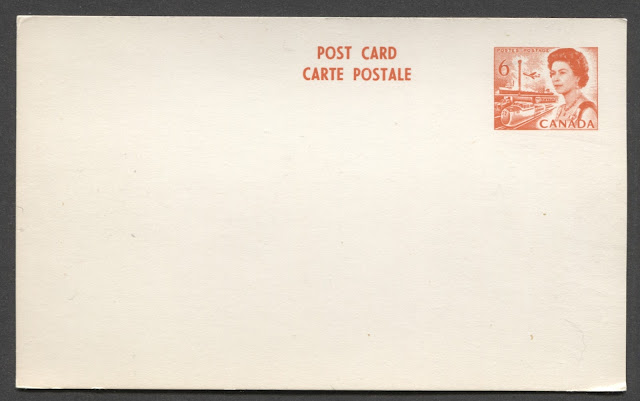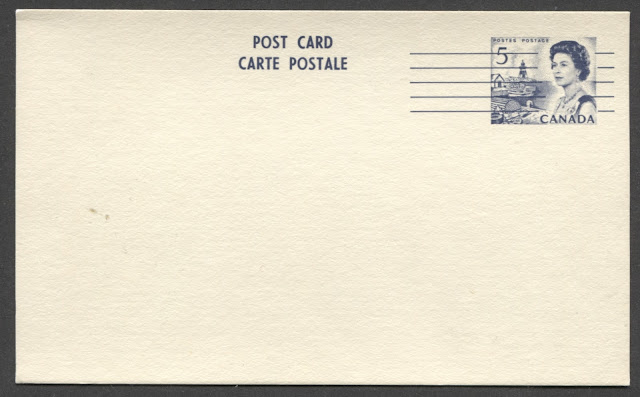Today's post is the last before I start a series of posts to bring all of the information that I have discussed in my previous posts together, to produce a comprehensive listing of all known varieties of each denomination in the issue, as well as to give tips for sorting large quantities of mint or used stamps with maximum efficiency. Before I get into that however, there is one last aspect of this issue that I need to touch on: the postal stationery.
The postal stationery of the 1967-73 Centennial issue is a very complex field in its own right, and contains some of the rarest and most sought after items in this issue. It consists of:


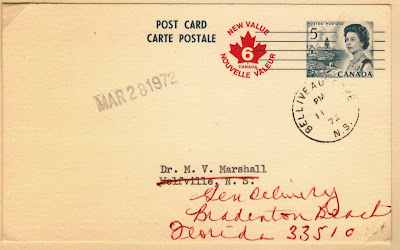


Canadian Pacific and CN rail had triplicate and folded cards like the ones shown below that were used to advise of shipments that were being held by them, presumably for pick up. These would generally bear the indicta for the first class mail rate, and would vary depending on what the rate in use was at the time.
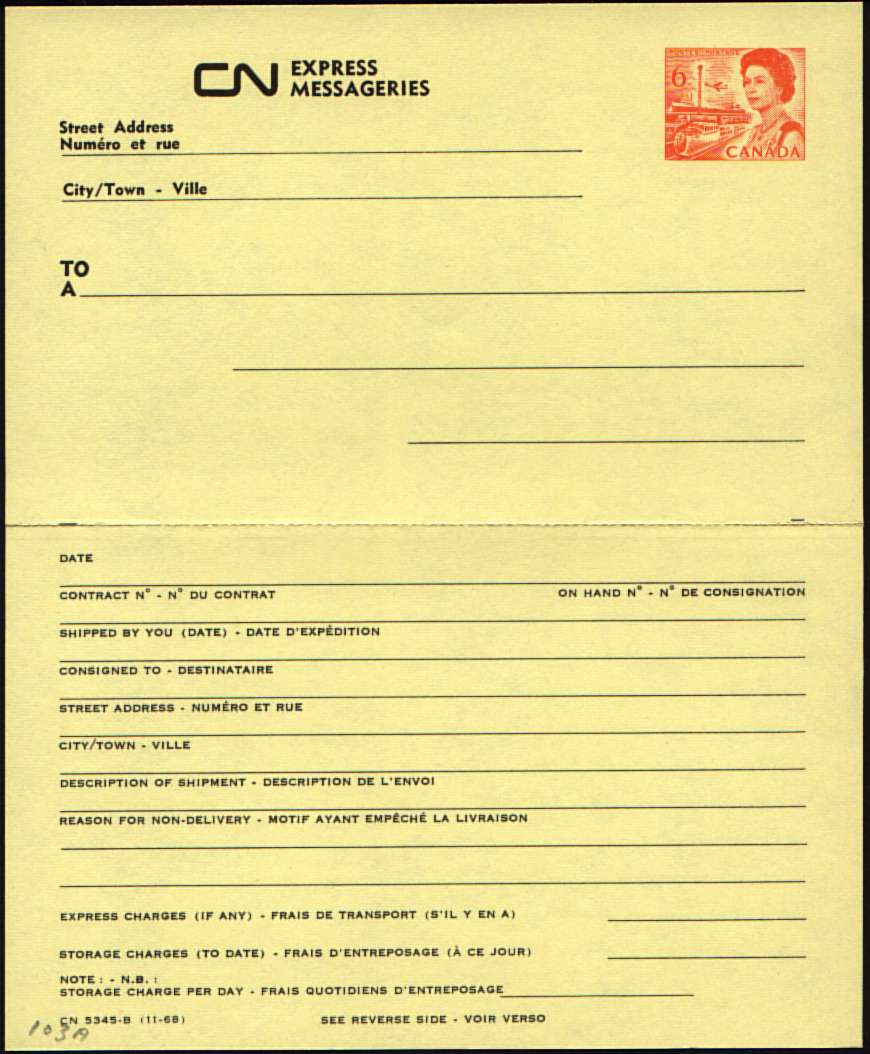
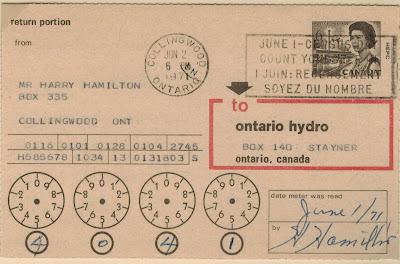
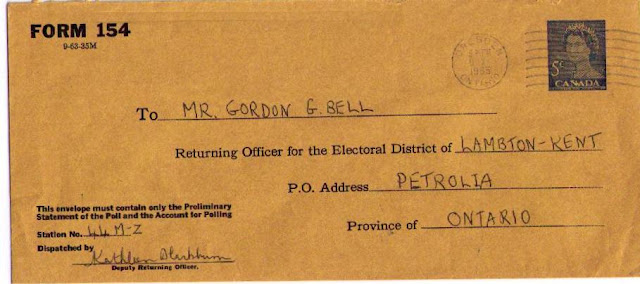
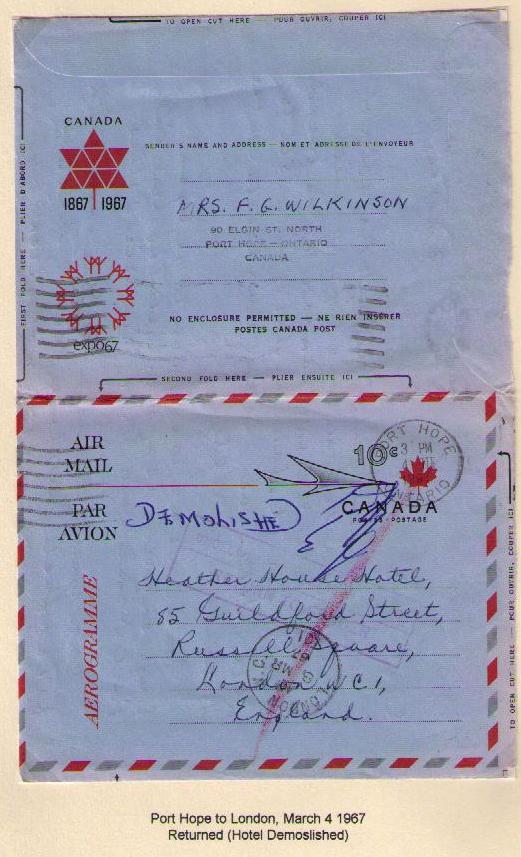
Postcards on this issue become much simpler as compared to previous issues, with the above bilingual inscription being the standard on these. Apart from differences in the shades of the indicta, there are differences in the card stocks used. The standard stock is usually a thin, smooth cream coloured stock. A thicker, porous stock for use in mimeograph machines is also found. This later stock is recognized by the rougher surface texture, the thickness and presence of pores. Some of these mimeograph cards can also be found rouletted.
Most cards were generally the same size as shown above, being 140 mm x 86 mm. Starting with the 8c slate, a larger sized card was produced measuring 140 mm x 89 mm. As with the pre-printed envelopes, precancelled versions of these cards were sold, but only for the third class rates. An example of a 5c precancelled card on mimeograph stock is shown below:

The postal stationery of the 1967-73 Centennial issue is a very complex field in its own right, and contains some of the rarest and most sought after items in this issue. It consists of:
- Pre-stamped envelopes
- Private-order stationery
- Election envelopes
- Letter sheets
- Aerogrammes
- Postcards
I only have a few items in stock and there are only a limited number of images available online for me to illustrate the complexity of this material. Consequently, today's post will serve as a brief introduction to this material. Then, as I get more material to examine, I can write and publish more detailed posts dealing with some of the varieties of each major class of postal stationery item in more detail.
With postal stationery items, there are several attributes that will vary that can be studied in detail:
- The paper stock used and its properties.
- The construction, where the item is an envelope.
- The size of the stamp indicta.
- The colour of the stamp indicta.
- Any other design characteristics of the stamp indicta.
- The dimensions of the item.
- The style, layout and dimensions of the pre-printed text.
The private order material is the scarcest and most difficult material to study, since by its nature, there were no standard paper stocks or dimensions used, as everything was made to order. It is possible that new finds may still be made, even 50 years on. However, the centennial study groups have a lot of members and are very active, so they have probably uncovered most, if not all of the existing material by now.
Pre-Stamped Envelopes

#8 and #10 sized envelopes were made available to the public throughout the duration of this issue. Generally, the available demominations were 3c through 8c, which allowed for the third class, local letter, forwarded letter and first class letter rates. These envelopes could either be plain and unprinted on the front, or they could be overprinted by businesses that would include their contact information, or a slogan, as shown above.
Apart from the differences in size, the main point of interest that specialists study in collecting these envelopes are the type of envelope stock used. Unitrade lists three main types of envelope stock:
- Plain white paper (type A).
- Plain white on the outside, with a repeating "Canada Post Postes" pattern along the inside (Type B).
- As 2 above, but with a bilingual notice regarding the importance of apartment numbers as a part of a complete address (Type C).
The second and third types served as a security envelope, which was designed to conceal the contents from someone handling the envelope. Thus, these three types were in use concurrently, and it is important to note that the fluorescence of the paper used for the envelopes can vary as well. The specific varieties that can be found will be the subject of another post. In addition, shade varieties can exist on the stamp indicta as well, with printings made from the end of the run being printed in lighter or duller shades, as compared to the initial printings.
Finally, several of the envelopes exist precancelled. However, these were generally only sold as third class rate items. So initially, the only precancelled envelope on sale was the 3c, but as the basic postage rates started to increase in 1968, and the third class rates increased as well, the 5c and 6c envelopes were so issued as well. Tagging was also introduced on the 6c black and 8c slate envelopes. However, curiously no tagged version of the 7c envelope was issued.
Unitrade lists 31 basic, unsurcharged envelopes, as follows:
- #8 type A - 3c, 3c precancelled, 4c, 5c. 5c precancelled, 6c black precancelled, 6c precancelled tagged.
- #10 type A - 3c, 3c precancelled, 4c, 5c, 5c precancelled, 6c black precancelled, 6c black precancelled tagged.
- #8 type B - 4c, 5c, 6c orange, 6c black.
- #10 type B - 4c, 5c, 6c orange, 6c black.
- #8 type C - 6c black, 7c green, 8c slate, 8c slate tagged.
- #10 type C - 6c black, 7c green, 8c slate, 8c slate tagged.
Surcharged Envelopes
Between 1969 and 1971 unsold quantities of the 3c, 4c and 5c envelopes were surcharged by overprinting them with one of the two designs shown below:


The first design shown above was used for two separate printings of envelope:
- Gasparo Printing (Type A): the vertical stoke in the "C" runs entirely through it.
- International Printing (Type B): The vertical stroke does not run through the "C", protruding only from the top and the bottom.
The second design, showing the red maple leaf and the new value is known as the type C surcharge. The Gasparo printing is the scarcest type and was the one used for most of the envelopes listed in Unitrade. Some of the envelopes issued during this period were actually the earlier Cameo issue designs. The rarest envelopes from this group are actually a #10 example of the 4c violet Karsh envelope with the type A 6c surcharge, and #8 and #10 examples of the 5c Karsh design with a 6c surcharge.
For the earlier Cameo design envelopes, the first envelopes show the Queen's hair consisting of dots, while the later printings show the hair consisting of lines. In addition, there were three different sizes of stamp indicta used: 23 x 19 mm for the 3c, 24 x 21 mm used for the 4c, and 25 x 21 mm used for the 3c and 4c. The 23 x 19 mm and 24 x 21 mm sizes will be referred to as the small size, while the 25 x 21 mm design will be referred to as the large size.
The earlier Cameo Issue designs listed in Unitrade are as follows:
- #8 type A, hair consisting of dots: 6c on 4c (small and large).
- #10 type A, hair consisting of dots: 3c on 5c, 6c on 4c (small and large), 6c on 5c blue.
- #8 type A, hair consisting of lines: 3c on 5c (small and large), 6c on 4c (small and large), 6c on 6c blue.
- #10 type A, hair consisting of lines: 3c on 5c (small and large), 6c on 4c (small and large), 6c on 5c blue.
Then, the Centennial designs listed in Unitrade are as follows:
- #8 Type A: 5c on 3c purple (reg & precancelled), 6c on 4c (envelope type A &B), 6c on 5c blue (envelope type A, B and precancelled).
- #10 Type A: 5c on 3c purple (reg. & precanceled), 6c on 4c (envelope type A &B), 6c on 5c blue (envelope type A, B and precancelled).
- #8 Type B: 6c on 5c blue envelope type B.
- #10 Type B: 6c on 4c red envelope type B, 6c on 5c blue envelope type B.
- #8 Type C: 6c on 5c blue type C.
- #10 Type C: 6c on 5c blue type C.
Ralph Trimble, the noted specialist in Canadian re-entries notes that re-entries can be found on some, or all of the envelope indicta. These might actually be more in the nature of a double or triple print, but an example of the 6c orange indicta with clear doubling is shown below:
Unitrade does not list these re-entries, but there is no reason to believe, based on the image above, that these do not exist on all denomination of envelope.
In addition to the listed envelopes, there are a number of other freaks and errors that typically occur with most pre-printed envelopes, that can be collected on the Centennial issue as well:
- Envelopes that have the stamp impression on the inside of the envelope.
- Envelopes that have the stamp impression in the wrong location (i.e. not the upper right corner).
- Complete extra stamp impressions.
- Offset stamp impressions inside the envelope.
- Misplaced or double surcharges.
- Double folded envelopes.
I am not clear on which of the above types of varieties can be found on the Centennial issue envelopes. The above list is a generic list that Unitrade gives that can be applied to all of the pre-stamped envelope issues. It is thus probable that some of the varieties may not, in fact, be known on this issue. However, it is good to keep their potential existence in the back of one's mind when looking through large accumulations of postal stationery.
Private Order Stationery
The previous envelopes are those that were sold at Canadian post offices to members of the general public. However, it was possible for businesses to custom order various stationery items from the post office department that would have the stamp indicta printed directly on the item. These are some of the rarest and most sought after items in this issue.
Envelopes

Generally speaking, these envelopes are identified either by the fact that the size is not either the standard #8 or #10 size, or the envelope stock is different from the three types detailed earlier. The above envelope for instance is an ivory coloured envelope, rather than the standard white envelope on which the 6c precancelled black indicta is usually found.
Unitrade lists 12 special order envelopes as follows:
- 3c, 4c, 5c, 6c orange, 6c black, 7c green, 8c slate with large size indicta.
- 8c slate with small size indicta.
- 8c Alaska Highway in purple and in black.
- 5c and 6c black precancelled.
The black Alaska Highway envelopes usually bear the Sony logo, as Sony used these for business reply mail. These are extremely scarce and list in Unitrade at between $400 and $600 each, depending on whether or not they are mint or used.
It should be noted that Unitrade's listing is extremely simplified, as an almost infinte number of potentially different envelopes could exist, in a number of different sizes, on a number of different paper stocks.
Railway Advice Flimsies
Canadian Pacific and CN rail had triplicate and folded cards like the ones shown below that were used to advise of shipments that were being held by them, presumably for pick up. These would generally bear the indicta for the first class mail rate, and would vary depending on what the rate in use was at the time.
The Webb's postal stationery catalogue likely contains a comprehensive listing of the cards and forms that exist for CN rail and Canadian Pacific, but Unitrade does not have any such listing.
Meter Reading Cards

Various utility companies produced meter reading cards bearing stamp indicta. These were sent to homeowners who were asked to read their meter, record the reading on the card and then return the card to the utility company. The company I have most often seen is Ontario Hydro, but I would assume that other utility companies like BC Hydro and NB Power also used such cards as well.
Election Envelopes

I don't have an image of an election envelope from this issue, but I have included a Karsh era envelope above to give you an idea of what these envelopes generally looked like. These were produced for use by election officials in mailings associated with election business. All election envelopes known from this issue are #10 envelopes and Unitrade lists only two: a 6c black and 8c slate. These were issued between 1972 and 1974. Before that, a 5c blue and a 6c on 5c blue Cameo design was in use. As with the private order envelopes, these envelopes can be found on a number of different paper stocks, and I would bet that it is possible to find the two different size stamp impressions that are found with the other envelopes as well.
Letter Sheets (Domestogrammes)
Domestogrammes are folded letter sheets, like airletters, which were designed to be written on, folded and sealed, and then mailed locally. They were first issued in 1973, which is the very tail end of this issue. Consequently, the 8c slate is the only value in which these are found. Unitrade lists two different sizes:
- The small size: 185 mm x 257 mm.
- The larger size: 203 mm x 343 mm.
Aerogrammes

Aerogrammes are folded letter sheets that were produced for foreign correspondence. They are the only postal stationery item from this period in which the basic design is different from the issued stamps of the series. The above stylized airplane design is one of the basic designs that was in use from 1967 until 1972, when a new design featuring a maple leaf and a goose replaced it.
Of this original design, there are two basic types. The first had the centennial emblem and Expo 67 emblems printed on the back of the sheet, as shown in the above scan. These were in use from 1966 until 1968. Unitrade lists two basic sub-types:
- One has a dotted line at the caption "first fold here".
- Another types has no dotted line at "first fold here"
Then, starting in 1968, a second type appears in which there is no centennial or Expo 67 emblem on the back. Of these, there are two basic sub-types:
- One has 52 mm lines for the senders address.
- Another has 67 mm lines for the senders address.
The 1971 new design, shows "Canada 15" printed over a maple leaf. Initially, these had no decorative panel on the back of the sheet. Later, these were issued with a decorative panel on the back. Of these later designs, there are five basic sub-types:
- One has angled flap corners.
- One has rounded flap corners and no dots before or after the words "to open".
- One is as "2" above, but tagged.
- One has rounded flap corners and dots before and after the words "to open".
- One is as "4" above, but tagged.
Postcards
Postcards on this issue become much simpler as compared to previous issues, with the above bilingual inscription being the standard on these. Apart from differences in the shades of the indicta, there are differences in the card stocks used. The standard stock is usually a thin, smooth cream coloured stock. A thicker, porous stock for use in mimeograph machines is also found. This later stock is recognized by the rougher surface texture, the thickness and presence of pores. Some of these mimeograph cards can also be found rouletted.
Most cards were generally the same size as shown above, being 140 mm x 86 mm. Starting with the 8c slate, a larger sized card was produced measuring 140 mm x 89 mm. As with the pre-printed envelopes, precancelled versions of these cards were sold, but only for the third class rates. An example of a 5c precancelled card on mimeograph stock is shown below:
Unitrade lists 17 basic types of cards, which can be summarized as follows:
- Precancelled on normal stock: 3c violet, 3c +3c reply, 5c blue, 6c black (20 mm x 16 mm stamp).
- Mimeograph stock precanceled : 3c violet, 5c blue, 6c black (20 mm x 16 mm stamp).
- Mimeograph stock, precancelled and rouletted: 3c violet, 5c blue, 6c black (20 mm x 16 mm stamp).
- Regular stock, 140 x 86 mm: 4c red, 6c orange, 6c black (24 mm x 19 mm stamp), 7c green, 8c slate.
- Regular stock, 140 x 89 mm: 8c slate and 8c slate tagged.
The taggant found on the tagged 8c slate card is OP-2 Ottawa tagging and glows bright yellow under UV light.
Surcharged Postcards

As was the case with the pre-stamped envelopes, a large stock of the 3c, 4c and 5c postcards from the earlier Cameo issue and this issue were surcharged using the same designs and types as discussed on the envelopes, only this time, instead of Gasparo and International printings, these are the Gasparo and British American Bank Note Company printings. Although the basic appearance of the three types is the same for these printings as the pre-stamped envelopes, the specific characteristics along which they differ are slightly different as follows:
- Type A Gasparo printings have a sloping back on the "5" of 5c and the "5" is 4 mm high. The "c" on the 6c is shallow.
- Type B BABN printings have a straight back on the "5" of 5c and the "5" is 5 mm high. The 6c has a bolder "6" and the "c" is more rounded.
- Type C with the red maple leaf is the same as on the pre-stamped envelopes, and is shown above.
As was also the case with the envelopes, the first cards to be overprinted were those of the previous Cameo Issue. With the cards though, the design is simpler, with no dots versus lines distinction in the hair and only one size of stamp image. Unitrade lists the following cards in this design:
- Type A: 5c on 3c violet precancelled and 5c on 3c precancelled on mimeo stock, 5c on 3c precancelled no inscription, 6c on 4c red.
- Type B: 5c on 3c violet precancelled, no inscription, 5c on 3c violet precancelled, 5c on 3c precancelled on mimeo rouletted stock, 6c on 4c red, 6c on 4c red no inscription.
Type C is only found with the Centennial design cards. The cards of the Centennial design, listed by Unitrade are:
- Type A: 5c on 3c violet precancelled, 5c on 3c violet precancelled on mimeo stock, 6c on 4c red.
- Type B: 5c on 3c violet precancelled, 5c on 3c violet precancelled on mimeo stock, 5c on 3c violet precancelled on mimeo rouletted stock, 6c on 4c red.
- Type C: 6c on 5c blue precanceled, 6c on 5c blue precancelled on mimeo stock, 6c on 5c precancelled on mimeo rouletted stock.
This concludes my overview of the postal stationery of this issue, and brings me to the end of my discussion of the fundamentals of this issue. I am now ready to take this information and begin to put together a comprehensive list of varieties for each of the denominations of the series. Next week's post will begin with an overview of the 1c Northern Lights and Dogsled Team stamp from the series.


